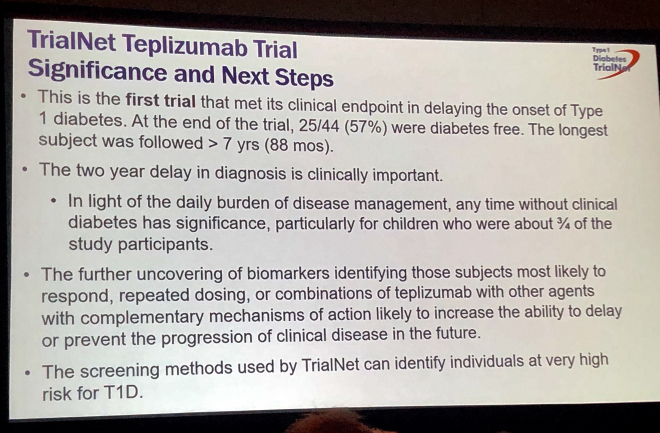Preventing Type 1 Diabetes: Results From TrialNet’s Landmark Teplizumab Trial
On June 9, 2019 TrialNet announced a breakthrough in type 1 diabetes prevention.
In study results presented at the American Diabetes Association’s 79th Annual Scientific Sessions and published in the New England Journal of Medicine, the immunotherapy drug teplizumab was shown to delay type 1 diabetes diagnosis a median of two years in children and adults at high risk.
The TrialNet Teplizumab Prevention Study focused on relatives of people with type 1 diabetes who had had two or more autoantibodies and abnormal blood sugar levels. The lifetime risk of the 76 individuals ages 8-49 who participated in the study of developing type 1 diabetes (T1D) was thought to be 100 percent.
During the trial, 72 percent of people in the control group receiving placebos developed type 1 diabetes, compared to only 43 percent of those receiving a single two-week treatment of teplizumab.

TrialNet Teplizumab Prevention Study Chair Kevan Herold, M.D. said, “This is the first study to show any drug can delay type 1 diabetes diagnosis a median of two years in people at high risk. As anyone with type 1 diabetes will tell you, and particularly for children who are most commonly affected, every day you can delay this disease is important.”
Type 1 diabetes is an autoimmune disease that occurs when the body attacks the insulin-producing beta cells in the pancreas. Over time, people with type 1 diabetes are left with none of these beta cells, also known as islet cells, and therefore cannot produce their own insulin. Teplizumab is an anti-CD3 monoclonal antibody that works by interfering with the body’s immune system’s destruction of the beta cells.
Previous studies had shown benefits of using Teplizumab in people recently diagnosed with T1D in slowing C-peptide decline, but this is the first study to test people who have a high risk for diagnosis. This study demonstrates that type 1 diabetes is an autoimmune disease that can be delayed with immune therapy.
The research conducted by TrialNet was funded by the National Institutes of Health (NIH), with additional support from JDRF. TrialNet is a network of researchers working to identify type 1 diabetes at its earliest stages and find ways to delay or prevent the condition in individuals at risk, namely relatives of people with T1D who have a higher chance of developing the disease when compared to the general population.
“These results and the potential impact to people living with type 1 diabetes and their families is exactly why JDRF funds prevention research.” said Aaron J. Kowalski, Ph.D., JDRF president and CEO. “Delaying the progression of the disease is an essential and impactful step toward the prevention, and ultimately a cure for type 1, as a delay in diagnosis is likely to have long-term benefits on glycemic control and the development of acute and long-term complications of type 1 diabetes.”
Researchers cautioned that the study did have some limitations, such as the small number of participants, lack of economic diversity, and that all participants were relatives of people with type 1 diabetes.
“While the results are encouraging, more research needs to be done to address the trial’s limitations, as well as to fully understand the mechanisms of action, long-term efficacy and safety of the treatment,” said Lisa Spain, Ph.D., project scientist from the NIH’s National Institute of Diabetes and Digestive and Kidney Diseases (NIDDK), sponsor of TrialNet.
This article is part of Beyond Type 1’s ADA 2019 coverage. For full ADA 2019 coverage, click here.
To learn more about all the great T1D research being funded by JDRF, visit their research and impact page here.





